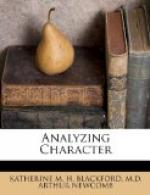For more than four thousand years—perhaps more than five thousand—men have been constructing buildings with bricks. Brick-laying was a trade, a skilled occupation, almost a profession, but its methods were based upon traditions handed down from father to son, from journeyman to apprentice, unbroken throughout that entire four-thousand-year period.
Then a bricklayer and his wife defied the heavens to fall, threw aside traditions and began to apply exact knowledge to brick-laying. As a result, they learned how to lay bricks three times as rapidly as the best workman had ever been able to before—and with less fatigue.
SCIENCE TAKES THE PLACE OF GUESSWORK
Fifty years ago, the merchant and the manufacturer guessed at their costs and fixed their prices with shrewd estimates as to their probable profits. They also guessed as to which departments of their business paid the most profit, how much and what kind of material they should buy, where the best markets were to be found, what would be the best location for their stores and factories, and many other important factors of profitable enterprise. Some of these old worthies were good guessers. They built up fairly large business institutions and made some very comfortable fortunes.
The business men of to-day—who are, indeed, of to-day and not a relic of yesterday and the day before yesterday—have an exact and detailed knowledge of their costs, determine prices scientifically, know definitely where are the best markets and what are the best locations for their factories, forecast with a reasonable degree of accuracy their need for materials, determine in a laboratory just which materials will best supply their needs, and in many other ways walk upon solid highways of exact information rather than upon the quaking bog of guesswork. Partly because of this, they have built up a multitude of institutions, each of them far larger than the largest of the olden days and have made fortunes which make the big accumulations of other days seem like mere pocket money. In making these fortunes for themselves, they have enabled millions not only to enjoy far larger incomes than people of their class and situation ever received before, but to enjoy conveniences and luxuries beyond even the dreams of the rich men and kings of olden days.
RANDOM METHODS YIELD TO SCIENTIFIC
In the old-time factories the various departments of work, machinery and equipment in each of the departments were arranged almost at random. Even a few years ago we sometimes saw factories in which the materials worked upon were moved upstairs, then downstairs, then back upstairs, hither and yon, until a diagram of their wanderings looked like a tangle of yarn. Even in offices, desks were placed at random and letters, orders, memoranda, and other documents and papers were moved about with all of the orderliness and method of a school-girl playing “pussy wants a corner.” Modern scientific management, horrified at the waste of time and energy, makes accurate knowledge take the place of this random, helter-skelter, hit-or-miss basis of action and multiplies profits.




